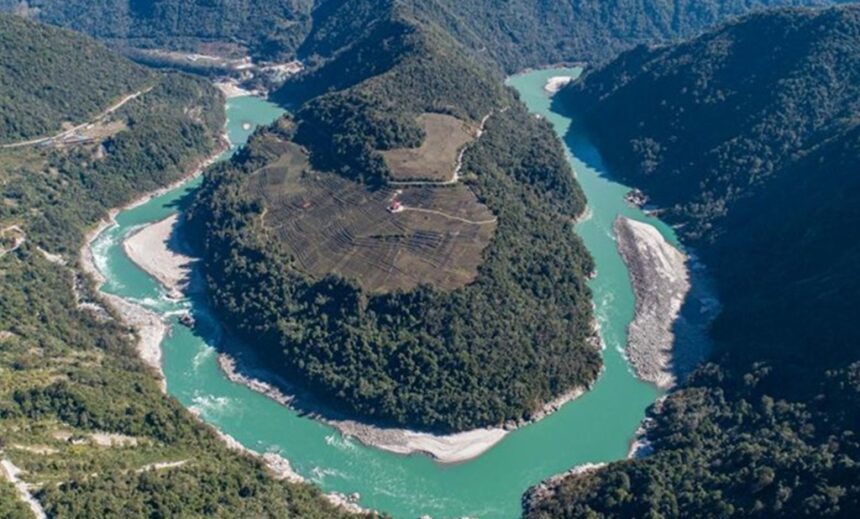BEIJING – China has moved forward with plans to build the world’s largest hydroelectric dam on the Yarlung Tsangpo River in Tibet’s Medog County, close to India’s border, despite protests from India, Bangladesh and local communities along the river.
The Medog Hydropower Station comes with a $137 billion price tag and will generate more electricity than the Three Gorges Dam, delivering as much as 300 billion kilowatt-hours each year. That could supply power for up to 300 million people.
While China promotes it as a step towards green energy and economic growth, the project brings serious environmental risks, increases tensions with neighbouring countries, and threatens millions living downstream who rely on the river. With more dams across Asia’s most important rivers, the effects are being felt not just in India and Bangladesh, but in countries like Thailand as well.
The Yarlung Tsangpo starts in the frozen Himalayan glaciers, carving through remote canyons in Tibet before entering India as the Brahmaputra and flowing through Bangladesh as the Jamuna.
The new dam will sit at the “Great Bend” near Mount Namcha Barwa, using a dramatic drop of about 2,000 metres over 50 kilometres to create massive amounts of hydropower.
To make this work, engineers will build at least four tunnels spanning 20 kilometres each. The scale shows China’s intent to use Tibet’s rivers to meet its rising energy needs.
Officials in Beijing say the dam will help meet carbon goals by 2060 and reduce coal use. But the site lies in a region rich in unique species and prone to earthquakes. The Tibetan Plateau, often called Asia’s water source, feeds rivers that support over 1.3 billion people across ten countries.
The Yarlung Tsangpo itself plays a key role in the lives of millions in India and Bangladesh. Still, Chinese state media claims little harm will come from the dam. Many scientists and neighbouring countries are not convinced.
Downstream Risks: Concerns in India and Bangladesh
In India, the dam’s impact is not only about the environment but also about national security. The Yarlung Tsangpo becomes the Brahmaputra after it enters Arunachal Pradesh and Assam, which China claims as its territory. With the new dam, China will have control over the water flowing into these areas.
This power to restrict or release water puts India’s economy and people at risk. A Lowy Institute report from 2020 described China’s grip as a “chokehold.”
Experts in India warn that manipulating water levels could either cut off supplies to fields and homes or cause heavy flooding during disputes. Arunachal Pradesh’s chief minister, Pema Khandu, warned of the danger to large populations if water is used as a weapon.
India’s answer is to propose its dam on the Siang River, despite local protests. The Adi community, who view the river as sacred, have already started demonstrations. Critics fear a chain reaction, causing more damage to the region’s natural balance.
In Bangladesh, the river is crucial for farming and fishing. Any change in river flow affects two million people, many of whom depend on species such as Hilsa and Mahseer. These fish are already struggling due to water flow changes and shifting sediment.
China’s reluctance to share detailed water data increases anxiety in the region. Although a 2013 agreement aimed to encourage sharing information during the monsoon season, China has made little progress.
Ashok Kantha, a former Indian ambassador, stressed the need for openness, noting that past floods were made worse by poor cooperation. Without real agreements on water sharing, India and Bangladesh remain exposed to risk.
The Mekong’s Lesson
China’s activity on the Yarlung Tsangpo is part of a broader push to control Asia’s rivers. The most obvious example comes from the Mekong. Since the 1990s, China has built 11 large dams on the upper reaches of the Mekong (called the Lancang in China).
These structures have cut sediment flow by over half, leading to riverbank damage, falling fish numbers, and trouble for 60 million people depending on the river. Thailand, Vietnam, and Cambodia all report losses.
In Thailand, fishermen watch stocks drop and iconic species like the Mekong giant catfish vanish. The dams block fish migration and change water levels, worsening drought and hurting agriculture. Research published in 2023 showed how trapped sediment has wrecked local fishing industries.
In Vietnam, the Mekong Delta – a key rice-producing area – now suffers from saltwater intrusion and reduced yields. China’s refusal to coordinate with the Mekong River Commission means these countries often have little choice but to deal with the fallout.
Damage to Nature and Culture
The region near the Yarlung Tsangpo is one of Tibet’s richest for wildlife. Ancient forests and a wide range of large animals, including rare cats, face serious risks. Ecologist Yu Ren has called for urgent steps to defend these habitats.
The land lies on a fault where tectonic plates meet, making it prone to earthquakes. Past disasters, like the 1950 Assam-Tibet quake or the magnitude 6.8 tremor in early 2025, show what can happen if stability is lost.
For Tibetans, the story is also about the ongoing use of their land for projects that serve outside interests. While not as crowded as the Three Gorges area, Medog County will likely see thousands of people moved and holy places, such as Buddhist monasteries, submerged.
Protests have happened before. In 2024, over 1,000 Tibetans were detained after speaking out against another project on the Drichu River. Many activists say government promises of fair treatment and compensation hide the destruction of local culture and community ties.
China’s Drive for Energy and Influence
China’s rush to build dams comes from its hunger for energy and desire to lead in renewable power. Tibet holds much of the country’s possible hydropower. The Medog project alone could triple the electricity of the Three Gorges and send it to the main industrial zones by way of new power lines.
Still, this focus on “green” energy often leads to major costs for nature and people. Past projects like Three Gorges have already shown how lower sediment levels can hurt farming and diverse species. The same risks now surround the Yarlung Tsangpo.
China’s approach often ignores the worries of its neighbours and its communities. Officials, including Wang Lei from the Chinese embassy in India, claim the dam poses no risk to those downstream, but repeated delays in sharing information and past secrecy have left many skeptical.
The country’s promise to keep lines open during disasters lacks the structure of binding water-sharing deals. The Mekong countries know this too well, as droughts and falling water levels keep getting worse with more dams upstream.
With construction moving forward, China’s Yarlung Tsangpo mega-dam stands as a warning of the risks that come with unchecked hydropower development. For India, Bangladesh, and countries on the Mekong, the future of water, food, and culture is at stake.
Building competing dams will only add to the harm and put fragile mountain ecosystems under greater strain.
Neighbours and the wider world must call for open data and real agreements to guard the rights of those downstream. Tibetans, caught between big interests and pressures to stay silent, should be part of decisions made about their land.
Without stronger action, the dam will not only change the course of the Yarlung Tsangpo but could deepen divisions across Asia and leave millions to deal with the fallout of unchecked ambition.














